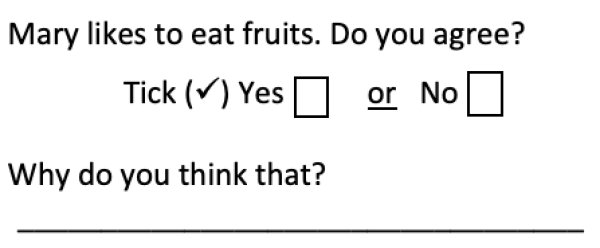Performance » Reading » Recommendations for teachers:
Describing character behaviour using evidence in text
The next reading area that students from PILNA 2021 had difficulty with was describing character behaviour using evidence from text.
These questions require students to read a short text sample; identify a character’s behaviour or attitude; and then give evidence from the text to justify their identification.
Example question
An example of one of these questions and how students responded to it is provided. This is a more difficult example from the assessment. It requires students to select an opinion about a text and then justify this with evidence where both opinions can be correct.
Figure DEF#5 / Sample question:
Support an opinion about a character’s likely behaviour using evidence from the text.
Question:
Read the text below and then answer the question.
Mary likes mangoes. Daniel gives Mary a banana. Mary is sad. Daniel picks a mango from his tree. Mary smiles and takes the mango. Daniel eats the banana.

Learning outcome:
This is a question with two parts and where students are required to do two things.
First, students are to decide whether they agree or disagree with the statement by placing a tick beside Yes or NO whichever is appropriate.
Then they need to write the reason for their choice using clues given in the text.
Responses:
Selects either Yes or No and uses clues from the text to support choice.
Yes – likes mangoes, smiles when given one
No – only some fruit/only mangoes, sad when given bananas
Level of difficulty:
We would expect only higher performing Year 4 and Year 6 students to successfully answer this question.
The question item is asked of both Year 4 and Year 6 students.
The question item is on level 6 of the literacy proficiency descriptors, which is above the minimum level of proficiency expected from Year 4 (level 4) and also Year 6 (level 5).
Performance analysis:
This question was above the expected minimum level of reading performance for year six students and substantially above the minimum expected performance for year four students. Only high performing year six students and very high performing year four students were expected to answer this correctly.
9% of year four students and 16% of year six students answered correctly. Most year four (69%) and year six students (64%) selected an opinion but gave vague or irrelevant evidence for their choice. A small number of year four (6%) and year six (9%) students selected an opinion but did not give any evidence and the remainder left the question blank (Year four, 16%; Year six, 12%).
There may be a need to support students’ abilities to make inferences from texts. This question shows that most students were able to identify, or guess, an opinion but were not able to substantiate it. Students may need support in identifying or using evidence from texts.
How can teachers support learning in this area?
Addressing how these types of questions are taught in schools may increase student performance in this area in future.
Students need to engage in higher order thinking skills, particularly, making inferences – a skill sometimes considered as ‘reading between the lines’ of a text. Higher order thinking skills include inferring, reasoning, generalising, summarising, making comparisons, sequencing, and predicting.
Below, SPC present some ways that teachers might support these higher order thinking skills.
- Discuss interpretations of information in texts as a class or in small groups. This can include giving an interpretation of a text to groups and asking them to find information in the text to support this interpretation. Groups can also be provided with a range of interpretations relating to a text and be asked to identify which are accurate and which are not, providing evidence from the text to support their findings.
- Support students’ understanding of underlying meaning by creating an activity that requires them to look at the intention behind a particular phrase or title. This could include providing a selection of short texts on a single topic, each of which suggests a different authorial intention or tone, for example fear, celebration, anger, humour. Students are then given a list of titles that represent those intentions or tones and have to match them to the appropriate text. Depending on their proficiency level, students could also be asked to produce their own short text and a title that represents the intention or tone of that text.
- Regularly discuss ideas in texts with students, particularly those that are not directly stated and require students to infer or interpret. Ask open-ended questions (using beginnings such as ‘what’, ‘why’ and ‘how’) and encourage students to explain their thoughts.
- Let students practice answering items that have two parts to respond to, getting students to identify the two parts and give a complete response.








